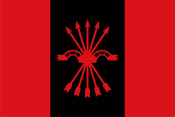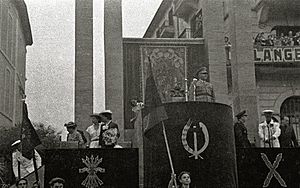FET y de las JONS facts for kids
Quick facts for kids
Traditionalist Spanish Phalanx of the Councils of the National Syndicalist Offensive
Falange Española Tradicionalista y de las Juntas de Ofensiva Nacional Sindicalista
|
|
|---|---|
 |
|
| Abbreviation | FET y de las JONS |
| Governing body | Movimiento Nacional |
| National Chief | Francisco Franco |
| Founded | 19 April 1937 |
| Dissolved | 7 April 1977 |
| Merger of | Traditionalist Communion Falange Española de las JONS |
| Headquarters | Calle de Alcalá 44, Madrid |
| Newspaper | Arriba |
| Student wing | Sindicato Español Universitario |
| Youth wing | Frente de Juventudes |
| Women's wing | Sección Femenina |
| Trade union | Spanish Syndical Organization |
| Sports body | Delegación Nacional de Deportes |
| Membership | |
| Ideology |
|
| Political position | Far-right |
| Religion | Roman Catholicism |
| European affiliation | European Social Movement |
| Colours | Red Black |
| Anthem | Cara al Sol |
| Party flag | |
 |
|
The Falange Española Tradicionalista y de las Juntas de Ofensiva Nacional Sindicalista (FET y de las JONS) was the only legal political party in Francoist Spain. It was created by General Francisco Franco in 1937. He combined the Falange Española de las JONS (a party with ideas similar to fascism) with the Traditionalist Communion. The Traditionalist Communion was a group that supported the monarchy and Roman Catholicism.
Even though the name was long, people often called it "FET". The party kept most of the original Falange's ideas and its way of being organized. It was active until April 1977. In 1958, its name was changed to Movimiento Nacional.
Contents
History of the Falange Party
How the Falange Started
The FET y de las JONS came from three main groups. These were the Spanish Falange, the Council of National Syndicalist Offensives, and the Traditionalist Communion. All three were becoming important in Spanish politics before the Spanish Civil War.
The Spanish Falange and the Council of National Syndicalist Offensives were quite small at first. They joined together to form the Spanish Falange de la JONS before the 1936 election. When the Civil War began, the Falange quickly gained many members. The Traditionalist Communion, which was already strong, also gathered its supporters to fight the government.
The Falange During the Spanish Civil War
When the Spanish Civil War began in July 1936, the Falange fought alongside the Nationalists. They were against the Second Spanish Republic. The Falange grew very quickly, from a few thousand members to hundreds of thousands.
The party also had a women's group called the Sección Femenina. This group was led by Pilar, the sister of José Antonio Primo de Rivera. By the end of the war, this women's group had over half a million members. They helped the Nationalist forces by providing nursing and other support services.
The leader of the party became Manuel Hedilla. Many of the first leaders were either gone or held by the Republicans. One of them was José Antonio Primo de Rivera. He was a prisoner of the government. Because of this, his followers called him el Ausente, meaning "the Absent One". José Antonio Primo de Rivera was put to death on November 20, 1936. This day is now known as 20-N in Spain. His death made him a martyr for the Falangists.
On April 19, 1937, Francisco Franco issued a special order called the Unification Decree. This order forced the Falange to merge with the Carlist Comunión Tradicionalista. This created the Falange Española Tradicionalista y de las JONS (FET y de las JONS). Franco became the jefe nacional ("National Chief"), like a leader of a fascist party.
All other parties that supported the rebel side were closed down. However, their former members could join the FET as individuals. The new party's main ideas were based on the Falangists' "27 points". After the merger, this was reduced to 26 points. The new party used many Falangist symbols. These included the blue shirt, the yoked arrows, the red and black flag, and the anthem Cara al Sol.
Even with these symbols, the party was actually a broad group of nationalists. Franco controlled it very closely. Some members of the original Falange and many Carlists did not join the new unified party. Franco wanted to control the Falange after a disagreement between Hedilla and other leaders. This disagreement threatened the Nationalist war effort. Franco became the "Supreme Caudillo" of the FET. He had "the most absolute authority". This meant he could even choose who would lead after him. He was only answerable to "God and history".
The Falange lost many of its leaders during the war. About 60% of its members from before the war lost their lives. However, the new party gained control of the property of all other parties and trade unions. In 1938, all trade unions in Spain were brought under the Falange's control.
The Falange in Francoist Spain
After the Civil War, the party was responsible for creating the main ideas for Franco's government. Joining this party became a way for ambitious politicians to advance their careers. These new members were called camisas nuevas ("new shirts"). This was different from the "old shirts" who had been members before the war.
The number of members in the Falange/FET reached its highest point in 1942, with 932,000 members. Even though different nationalist groups officially joined together in 1937, there were still tensions. These were especially strong between dedicated Falangists and Carlists.
One example of this tension was the Begoña Incident in August 1942. During this event, some strong Falangist members caused trouble at a Carlist religious gathering in Bilbao. This incident led to problems within the government. Franco had to remove some of his ministers. Six Falangists were found responsible for the incident, and one person was punished.
By the middle of Second World War, Franco and the Falange leaders started to distance themselves from the European fascist groups, which were losing power. They began to emphasize that their government and the Falange had a unique "Spanish Catholic authoritarianism". In September 1943, new rules said that the Falange/FET should only be called a "movement" and not a "party".
The Falange also created groups for young people. Members of these groups were known as Flechas and Pelayos. They were part of the Spanish Youths Organization. Most of these young members wore red berets.
As Spain's relationship with the United States improved and the economy grew, the Falange's influence began to decrease. In 1965, the SEU, which was the party's student organization, was officially closed down. At the same time, the Falange's overall membership was getting smaller and older. By 1974, the average age of Falangists in Madrid was at least 55 years old. The few new members who joined mostly came from conservative and religious areas in northern Spain.
More to Explore
 In Spanish: Falange Española Tradicionalista y de las Juntas de Ofensiva Nacional Sindicalista para niños
In Spanish: Falange Española Tradicionalista y de las Juntas de Ofensiva Nacional Sindicalista para niños
Images for kids



